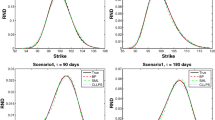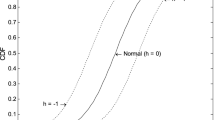Abstract
Here, we propose and investigate a hybrid model that combines parametric option pricing models such as Black–Scholes (BS) option pricing model, Monte Carlo option pricing model, and finite difference method with nonparametric machine learning techniques such as support vector regression (SVR) and extreme learning machine-based regression models. The purpose of this model is to support better investment decisions by forecasting the option price with high predictive accuracy. To further reduce the forecasting error, we incorporate a homogeneity hint (i.e., training the model by categorizing the options data based on moneyness and time-to-maturity of the option contract) into the model. We examine the feasibility and effectiveness of this model using a case study to predict the one-day-ahead price of index options traded in the National Stock Exchange of India Limited. Our experimental results show that the proposed new hybrid model is viable and effective and provides better predictive performance as compared with our benchmark models (standard BS Model, standard Monte Carlo, standard finite difference model, and standard SVR Model). For example, the proposed hybrid model using SVR improved, respectively, the root-mean-square error and mean absolute error by 83.66 and 85.46 % (D1 dataset), 78.02 and 76.0 % (D2 dataset), 91.86 and 90.62 % (D3 dataset), and 87.7 and 90.29 % (D4 dataset), when compared with the benchmarked BS model. We observe similar improvements over the other benchmarked models. Therefore, the proposed new hybrid model is a suitable alternative model for option pricing when higher predictive accuracy is desired.





Similar content being viewed by others
References
Adhikari R, Agrawal RK (2014) A combination of artificial neural network and random walk models for financial time forecasting. Neural Comput Appl 24(6):1441–1449. doi:10.1007/s00521-013-1386-y
Bakshi G, Cao C, Chen Z (1997) Empirical performance of alternative option pricing models. J Financ 52(5):2003–2049
Black F, Scholes M (1973) The pricing of options and corporate liabilities. J Polit Econ 81(3):637–654. doi:10.1086/260062
Boyle PP (1977) Options: a monte carlo approach. J Financ Econ 4(3):323–338
Brown CA, Robinson DM (2002) Skewness and kurtosis implied by option prices: a correction. J Financ Res 25(2):279–282
Can M, Fadda Š (2014) Using neural networks to forecast the implied volatility: the case of S&P100 XEO. SouthEast Eur J Soft Comput 3(1):10–17
Chang CC, Lin CJ (2011) LIBSVM: a library for support vector machines. ACM Trans Intell Syst Technol 2(3):27
Chen W-H, Shih J-Y, Wu S (2006) Comparison of support-vector machines and back propagation neural networks in forecasting the six major Asian stock markets. Int J Electron Financ 1(1):49–67
Chiarella C, Kang B, Meyer GH (2012) The evaluation of barrier option prices under stochastic volatility. Comput Math Appl 64(6):2034–2048
Cox JC, Ross SA, Rubinstein M (1979) Option pricing: a simplified approach. J Financ Econ 7(3):229–263. doi:10.1016/0304-405X(79)90015-1
Das SP, Padhy S (2015) A novel hybrid model using teaching–learning-based optimization and a support vector machine for commodity futures index forecasting. Int J Mach Learn Cybernet. doi:10.1007/s13042-015-0359-0
Diebold FX, Mariano RS (1995) Comparing predictive accuracy. J Bus Econ Stat 13(3):253–263. doi:10.1080/07350015.1995.10524599
Garcia R, Gençay R (2000) Pricing and hedging derivative securities with neural networks and a homogeneity hint. J Econom 94(1):93–115
Gencay R, Gibson R (2007) Model risk for European-style index options. IEEE Trans Neural Netw 18(1):193–202. doi:10.1109/TNN.2006.883005
Gencay R, Qi M (2001) Pricing and hedging derivative securities with neural networks: Bayesian regularization early stopping and bagging. IEEE Trans Neural Netw 12(4):726–734
Guo W, Xu T, Lu Z (2015) An integrated chaotic time series prediction model based on efficient extreme learning machine and differential evolution. Neural Comput Appl. doi:10.1007/s00521-015-1903-2
Hahn JT (2013) Option pricing using artificial neural networks: an Australian perspective. Dissertation, Bond University
Haykin S (2010) Neural networks and learning machines, 3rd edn. PHI Learning Private Limited, New Delhi
Heston SL (1993) A closed-form solution for options with stochastic volatility with applications to bond and currency options. Rev Financ Stud 6(2):327–343. doi:10.1093/rfs/6.2.327
Huang GB, Zhu QY, Siew CK (2004) Extreme learning machines: a new learning scheme of feedforward neural networks. In: Proceedings of international joint conference on neural networks, 2:985–990
Huang GB, Zhu QY, Siew CK (2006) Extreme learning machines: theory and applications. Neurocomputing 70(1):489–501
Huang S-C (2008) Online option price forecasting by using unscented Kalman filters and support vector machines. Expert Syst Appl 34(4):2819–2825
Hull JC, Basu S (2010) Options, futures, and other derivatives, 7th edn. Pearson Education Inc., India
Hutchinson JM, Lo AW, Poggio T (1994) A nonparametric approach to pricing and hedging derivative securities via learning networks. J Financ 49(3):851–889
Lajbcygier PR, Connor JT (1997) Improved option pricing using artificial neural networks and bootstrap methods. Int J Neural Syst 8(04):457–471. doi:10.1142/S0129065797000446
Liang X, Zhang H, Xiao J, Chen Y (2009) Improving option price forecasts with neural networks and support vector regressions. Neurocomputing 72(13):3055–3065
Mert I, Karakus C, Ünes F (2015) Estimating the energy production of the wind turbine using artificial neural network. Neural Comput Appl. doi:10.1007/s00521-015-1921-0
Park H, Kim N, Lee J (2014) Parametric models and non-parametric machine learning models for predicting option prices: empirical comparison study over KOSPI 200 Index options. Expert Syst Appl 41(11):5227–5237. doi:10.1016/j.eswa.2014.01.032
Park H, Lee J (2012) Forecasting nonnegative option price distributions using Bayesian kernel methods. Expert Syst Appl 39(18):13243–13252. doi:10.1016/j.eswa.2012.05.077
Rubinstein M (1998) Edgeworth binomial trees. J Deriv 5(3):20–27
Tavella D, Randall C (2000) Pricing financial instruments: the finite difference method. John Wiley & Sons, New York
Vähämaa S (2003) Skewness and kurtosis adjusted Black-Scholes model: a note on hedging performance. Financ Lett 1(5):6–12
Vapnik VN (1995) The nature of statistical learning theory. Springer, New York. ISBN 0-387-94559-8
Wang Y-H (2009) Nonlinear neural network forecasting model for stock index option price: Hybrid GJR–GARCH approach. Expert Syst Appl 36(1):564–570
Acknowledgments
We would like to express our gratitude to the National Institute of Science and Technology (NIST) for the facilities and resources provided at the Data Science Laboratory at NIST for the development of this study. The authors would also like to thank the editors and the anonymous reviewers for their insightful suggestions that improved the quality of this manuscript.
Author information
Authors and Affiliations
Corresponding author
Ethics declarations
Conflict of interest
The authors declare that there are no conflict of interests (either financial or nonfinancial) regarding the publication of the paper.
Rights and permissions
About this article
Cite this article
Das, S.P., Padhy, S. A new hybrid parametric and machine learning model with homogeneity hint for European-style index option pricing. Neural Comput & Applic 28, 4061–4077 (2017). https://doi.org/10.1007/s00521-016-2303-y
Received:
Accepted:
Published:
Issue Date:
DOI: https://doi.org/10.1007/s00521-016-2303-y




